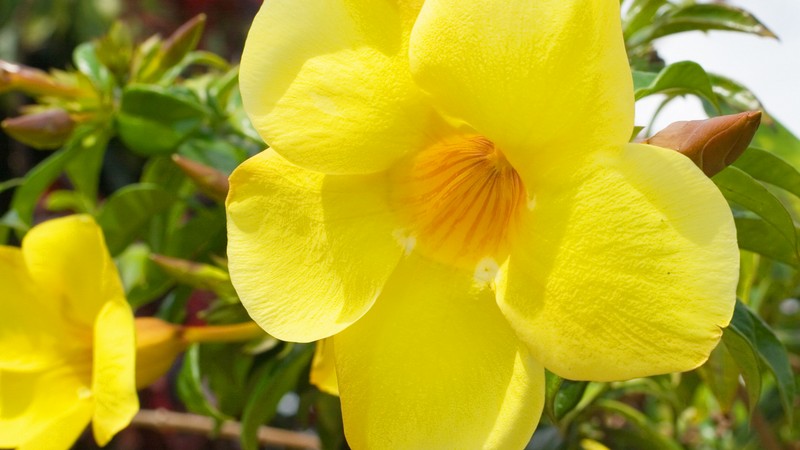The allamanda is the quintessential tropical shrub, colourful, flamboyant and even a tad sinister. A member of the dogbane or apocynaceae family, its stems contain a milky and poisonous latex. Technically a vine, its large, glossy, evergreen leaves are the perfect foil for flowers which are a burnished golden yellow, a colour that is even more intense at the heart of the blooms. Unsurprisingly, one of its names is the buttercup flower.
Up to 15 centimetres wide and seven centimetres long, these huge floral trumpets have a widely flared throat with five overlapping petals. They appear in clusters at the end of new shoots. Less pendulous than brugmansia bells which hang vertically down from brittle horizontal branches, allamanda flowers have stronger stems and look you straight in the eye from amid the shiny foliage. There are usually several lush ochrous yellow buds on a single stem, each one waiting to enjoy its day in the sun as the previous flower fades. The show never stops…
Allamandas are native to Central and South America where they grow so vigorously that they have become naturalised. In some corners of the globe, notably parts of Queensland, they have been declared invasive. In the wild, they are usually found near river banks, since they have a predilection for water. That is one cultural requirement you cannot ignore: the shrub does not like to dry out completely, but once established, it sends down deep tap roots that will withstand most periods of drought. Not one for a container though…
A real sun-worshipper, the allamanda moreover does not like full shade or, for that matter, strongly alkaline soil conditions. While the shrub can be propagated from seeds, most cultivars are sterile and do not produce the characteristic prickly seed pods. So your best bet is to propagate from cuttings. They take amazingly well.
Talking of cultivars, the allamanda has been extensively hybridized, especially in the southern United States where apricot, white (alba) and orange varieties exist. A double yellow variety known as flore pleno is also available in some garden centers.
A common inhabitant of Phuket gardens is the rose pink blanchetti, which has pale greenish-grey leaves. It is a less profuse bloomer, and grows less vigorously than cathartica, with a tendency to become straggly if deprived of full sun. Some gardeners train it into a standard form. “Chocolate Cherry” and “Chocolate Swirl” have distinctive purple-brown throats.
While cathartica is a rapid grower – it has been known to reach 15 metres in height ‒ it will not do so unsupported. After all, it is basically a tendril-less vine with a heavy superstructure. A wall with some anchor points to which the stems can be tied, is ideal. There it can show off its paces…
Other allamandas are less spectacular but are still useful garden plants. Schottii is a dwarf variety which is especially popular with municipal gardeners here. It has a compact form and has the same capacity as its bigger brother to flower more-or-less all year round. The flowers are smaller but of a similarly intense yellow. It is often used as a hedge since it responds well to pruning. Indeed, it will form a bushy plant if clipped regularly. If not it will become leggy, particularly if the supply of sun is limited. Unlike its bigger brother, the leaves are narrow and relatively insignificant. But it is much tougher, requires little or no maintenance, and will even adapt to life in a pot.
Going for gold? The allamanda is your best bet.
The information in this article and much more is to be found in my book ‘The Tropic Gardener’. Described in one Bangkok review as the best book on Thai gardening for 50 years, it is available for B500 (half price) to personal callers from 59/84 Soi Saiyuan 13 in Rawai (Tel: 076-61227 or 085-7827551).








